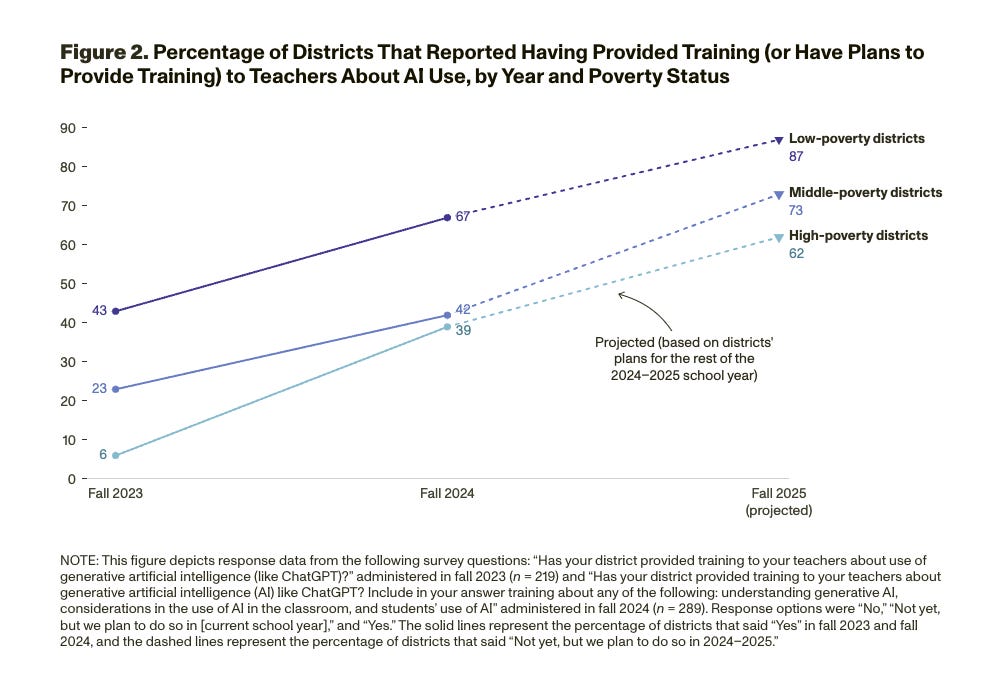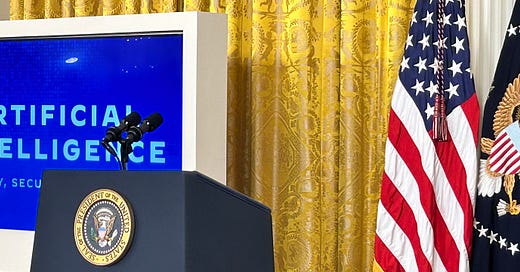What the AI Executive Order Means for K–12—and What Should Come Next
A special edition of Think Forward: Learning with AI
On Wednesday, the White House released an executive order on advancing AI education for America’s students. There have already been several good summaries and analyses of the EO itself. I especially liked this thorough run down by Nick Potkalitsky and this terrific Andrew Maynard comparison between the emerging U.S. and China strategies around education. I have been saying for a while that the U.S. is behind other countries when it comes to AI and education!
In general, there seems to be both a sense of optimism that the feds are finally asserting a proactive role in helping K-12 educators prepare for the AI revolution and a sense of concern about how this will roll out, especially considering the recent mass firings in both the Office of Educational Technology and IES.
Our sentiment at CRPE is similar. After two years of research on the demand side of AI in education (how are educators, schools, districts, and teacher training organizations responding?), we believe those preparing for this executive order should look to school districts already implementing generative AI to learn about effective educator support and training.
CRPE is leading the first national study on early adopter school districts. In partnership with RAND, we are also surveying a representative sample of school districts nationwide to learn about their teacher training efforts and related AI adoption needs. We have also surveyed colleges of education.
Our research shows that:
Adult and student AI literacy is crucial. AI raises new legal, ethical, and pedagogical questions fundamental to teaching and learning. AI also presents important opportunities to improve teaching and learning. Training and support to help teachers, principals, and students navigate these new realities is critical. Effective consumers make effective decisions. To achieve [or realize] the benefits of AI, districts and policymakers must invest in leaders’ and educators’ ability to use AI wisely.
Roughly half of all U.S. school districts have provided at least some AI training to their teachers. High-need and high-poverty districts are far behind more affluent districts and need the most help with teacher training. There is already a 25-point gap in access to AI training and policies between students in low-poverty and high-poverty districts.

Federal and state policy should encourage educators to use AI to transform learning, not just police it. Plagiarism is the most common focus on AI training, but the real promise of AI lies in accelerating learning and improving teacher effectiveness. In the long term, AI may present tangible opportunities to rewire longstanding, intractable challenges with new tools.
District leadership is essential—AI strategy must tie into learning strategies. Every early adopter school system we studied had superintendent support behind systemic AI adoption strategies. Those farthest ahead are thoughtfully choosing AI strategies in alignment with broader learning goals, rather than using them as ad hoc tools.
Districts want to partner with trusted sources like school boards associations and trusted intermediaries. External organizations can play a critical role in catalyzing systemic school adoption through learning cohorts and regional network building. Check out the Los Angeles County Office of Education, AI for Equity, and AI for Education for more work on this front.
District leaders say teacher training can backfire if not handled well, and they say it is difficult to find organizations that can provide effective AI teacher training. We learned from early adopter districts that training should:
be multimodal, ongoing, and adaptable to varying teacher needs,
address teacher fears and resistance,
focus on how AI can help teachers work more efficiently and differentiate learning based on student needs, and
not put too much weight on learning the latest tools, as they are changing so quickly.
Schools of education are, on the whole, not preparing teachers for the reality of AI in the classroom (though they should be).
Districts want federal and state governments to remove barriers and drive innovation in AI and education by providing clearer legal guardrails and guidance for schools and school systems. Policy setting for AI requires nuance given its rapidly evolving nature and unclear legal parameters.
As the federal government and states consider the role of AI in education, CRPE looks forward to sharing more insights on the conditions for success and the potential pitfalls to implementation, based on the rapidly evolving landscape for districts, teachers, and higher education leaders.





